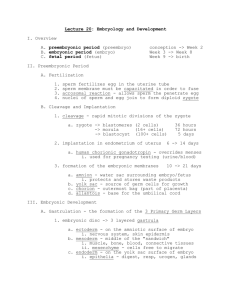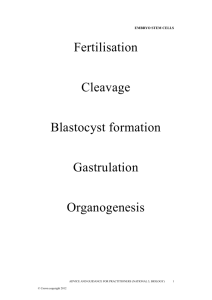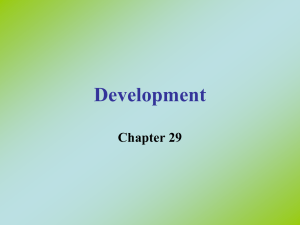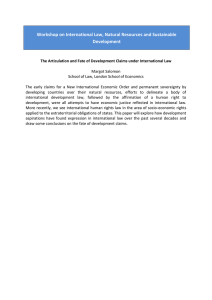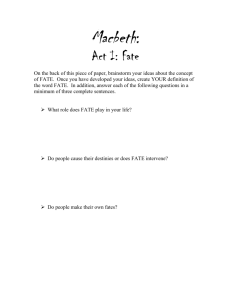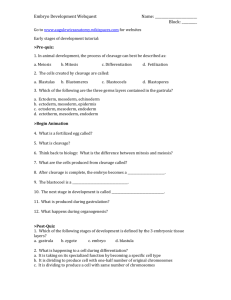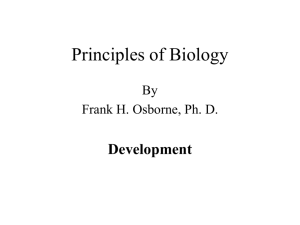Document 13541309
advertisement
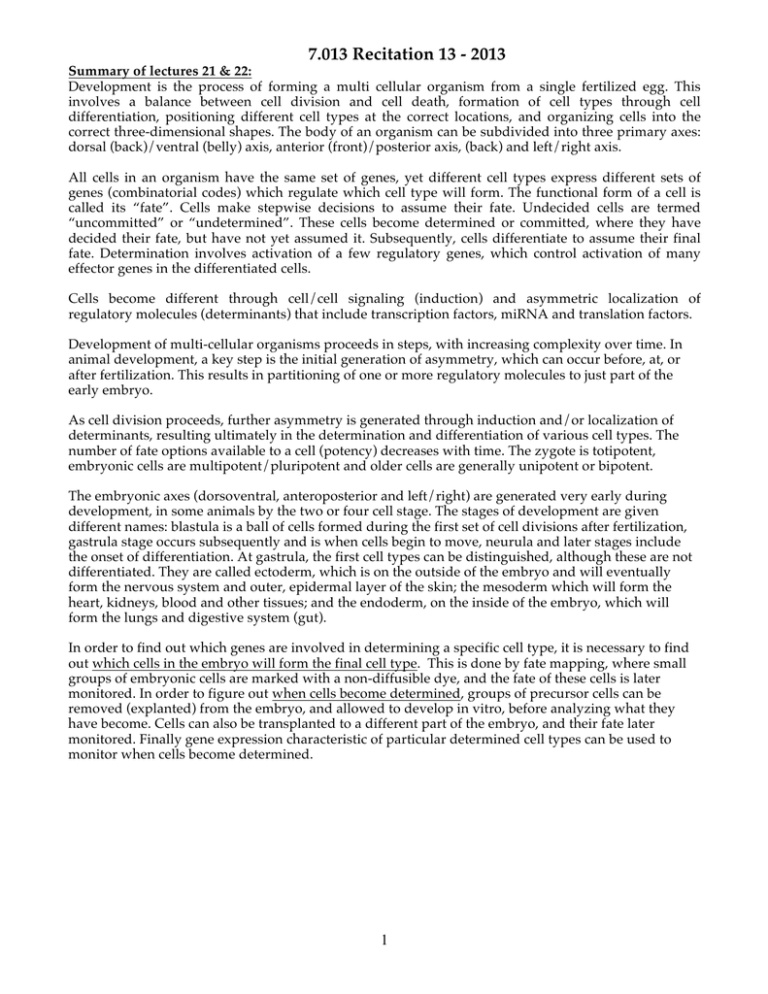
7.013 Recitation 13 - 2013 Summary of lectures 21 & 22: Development is the process of forming a multi cellular organism from a single fertilized egg. This involves a balance between cell division and cell death, formation of cell types through cell differentiation, positioning different cell types at the correct locations, and organizing cells into the correct three-dimensional shapes. The body of an organism can be subdivided into three primary axes: dorsal (back)/ventral (belly) axis, anterior (front)/posterior axis, (back) and left/right axis. All cells in an organism have the same set of genes, yet different cell types express different sets of genes (combinatorial codes) which regulate which cell type will form. The functional form of a cell is called its “fate”. Cells make stepwise decisions to assume their fate. Undecided cells are termed “uncommitted” or “undetermined”. These cells become determined or committed, where they have decided their fate, but have not yet assumed it. Subsequently, cells differentiate to assume their final fate. Determination involves activation of a few regulatory genes, which control activation of many effector genes in the differentiated cells. Cells become different through cell/cell signaling (induction) and asymmetric localization of regulatory molecules (determinants) that include transcription factors, miRNA and translation factors. Development of multi-cellular organisms proceeds in steps, with increasing complexity over time. In animal development, a key step is the initial generation of asymmetry, which can occur before, at, or after fertilization. This results in partitioning of one or more regulatory molecules to just part of the early embryo. As cell division proceeds, further asymmetry is generated through induction and/or localization of determinants, resulting ultimately in the determination and differentiation of various cell types. The number of fate options available to a cell (potency) decreases with time. The zygote is totipotent, embryonic cells are multipotent/pluripotent and older cells are generally unipotent or bipotent. The embryonic axes (dorsoventral, anteroposterior and left/right) are generated very early during development, in some animals by the two or four cell stage. The stages of development are given different names: blastula is a ball of cells formed during the first set of cell divisions after fertilization, gastrula stage occurs subsequently and is when cells begin to move, neurula and later stages include the onset of differentiation. At gastrula, the first cell types can be distinguished, although these are not differentiated. They are called ectoderm, which is on the outside of the embryo and will eventually form the nervous system and outer, epidermal layer of the skin; the mesoderm which will form the heart, kidneys, blood and other tissues; and the endoderm, on the inside of the embryo, which will form the lungs and digestive system (gut). In order to find out which genes are involved in determining a specific cell type, it is necessary to find out which cells in the embryo will form the final cell type. This is done by fate mapping, where small groups of embryonic cells are marked with a non-diffusible dye, and the fate of these cells is later monitored. In order to figure out when cells become determined, groups of precursor cells can be removed (explanted) from the embryo, and allowed to develop in vitro, before analyzing what they have become. Cells can also be transplanted to a different part of the embryo, and their fate later monitored. Finally gene expression characteristic of particular determined cell types can be used to monitor when cells become determined. 1 Questions 1. This question is about development of the alimentary canal (the “gut”) from the “endodermal” cell layer of the mouse embryo. This process requires contact between the endoderm (unshaded, labeled A, B, C, D in the diagrams below) and adjacent “mesodermal” cell layer (striped). Initially, a tube develops in the endoderm of the embryo. A few days later, the tube becomes kinked, and three days after that, four obvious morphological divisions (A, B, C, D) can be seen along the antero-posterior length of the tube, as diagrammed below. A, B, C, and D correspond the same regions at all stages (that will give rise to the esophagus, stomach, small intestine, large intestine, respectively). Differentiation occurs only at the latest stage, 1 week after the straight tube stage. A B A A C B C B C D D D In order to analyze the timing of stomach determination, you doCthe following transplant experiment within the whole embryo in which you invert the endoderm of regions A and B (the future esophagus and stomach) at either straight or kinked tube stage, as indicated below. The mesoderm is left intact and is not inverted. After the gut regions have differentiated, you observe that in the straight tube transplant, a normal gut develops, whereas in the kinked tube stage transplant, the position of the esophagus and stomach are inverted. i. Distinguish between “determination” and “differentiation.” ii. When does stomach determination occur? Explain. iii. In a second set of experiments, you isolate (explant) the endoderm of region B at the straight or kinked tube stage, and then culture it for one week. No mesoderm is removed. Based on the results of the transplant assay above, what would you predict the outcome would be? B ` 1 Week B 2 2. Leeches are medicinally important animals as they produce hirudin, a very effective anti-clotting agent. As embryos, they undergo interesting cell division, where a new row of cells is added at every division, so 1st row cells are the oldest cells, 2nd row cells are produced from division of 1st row cells, and 3rd row cells are produced from division of 2nd row cells. Based on patterns of gene expression, the following different “territories” (each a precursor to specific cell fates) are observed at each division. 2 cell stage 4 cell stage 6 cell stage a) Formulate a hypothesis, based on segregation of cell autonomous regulatory factors to account for the change in number of territories from the 2 cell to the 4 cell stage. What is the term for this type of regulatory factors? b) Formulate a hypothesis, based on cell-cell signaling to account for the change in number of territories from the 4 cell to the 6 cell stage. Comment on when this signaling is likely to occur. What is the term for this type of signaling? 3 MIT OpenCourseWare http://ocw.mit.edu 7.013 Introductory Biology Spring 2013 For information about citing these materials or our Terms of Use, visit: http://ocw.mit.edu/terms.
